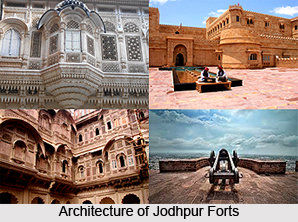 Jodhpur is a prominent city of Rajasthan and is a reservoir of magnificent palaces and majestic forts. Set in the landscape of the Thar Desert, the city of Jodhpur is known as the Sun City. It is also referred to as the Blue City due to the indigo tinge of the whitewashed houses around the Mehrangarh Fort. The old city of Jodhpur is surrounded by a stone wall and the new city is on the other side of the railway tracks, in the southeastern direction. The new palace houses the royal family in one half, while the other half is a high class hotel.
Jodhpur is a prominent city of Rajasthan and is a reservoir of magnificent palaces and majestic forts. Set in the landscape of the Thar Desert, the city of Jodhpur is known as the Sun City. It is also referred to as the Blue City due to the indigo tinge of the whitewashed houses around the Mehrangarh Fort. The old city of Jodhpur is surrounded by a stone wall and the new city is on the other side of the railway tracks, in the southeastern direction. The new palace houses the royal family in one half, while the other half is a high class hotel.
Jodhpur was the capital of the Marwar kingdom till the 13th century when the Rathore clan conquered it. In 1459, the present city was developed by Rao Jodha. A branch of this family built Bikaner, Pokhran and Jaisalmer. Jodhpur was a prominent nodal city for trade between the east and the west and is now the second largest city of Rajasthan. Jodhpur is a home of several new architectural patterns which has enriched the panorama of Indian architecture.
The Umaid Bhawan Palace of Jodhpur is noted for its imposing architectural features. The construction of the palace was actually aimed as a public relief and employment project during a long period of drought. Chittor sandstone has been used in the construction of this palace which imparts a special effect on it. The architecture of the palace was designed by a British architect who has rendered an indo saracenic style of architecture in it. The main features of architecture of Umaid Bhawan palace is beautiful balconies, green gardens, charming courtyards, and stately rooms. At present the palace has been converted into a heritage hotel and a royal museum. The Mehrangarh Fort majestically perched on a rocky mountain, at a height of hundred and twenty meters looks down on the city below. The architecture of the fort is very impressive and it is one of the largest forts in India. The fort wall has seven entrances and a number of palaces within, all connected with courtyards. The structures with their Bengaldar roofs bear a resemblance to the Bikaner Palace and have a strong influence of Islamic architecture. The only difference is that where Islamic palaces stand independ¬ently, here all the buildings stand in one continuous row.
The Jaswant Thada palace is half-way up the hill, built intricately with white marble and has elaborate sculptures in the traditional style. Inside is a big hall with a steel frame, built as a mausoleum for Jaswant Singh II. The exterior with its open platform and flowing water is especially noteworthy. The Balsamad lake palace of Jodhpur summer palace built in the European style, with a garden in the Mughal style, facing a man-made lake.
Jodhpur with numerous historical monuments and royal palaces is a coveted place for travelers. The architecture of Jaipur is renowned all over the world and makes it one of the most popular travel destinations.




